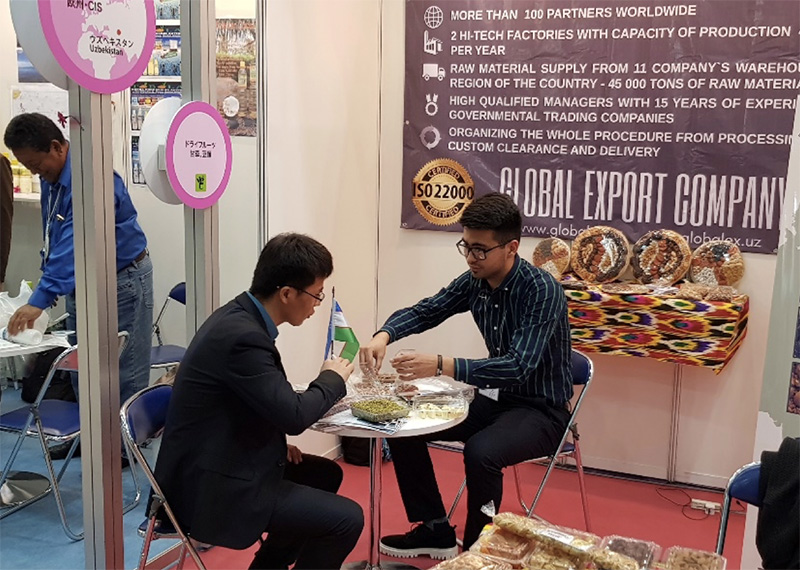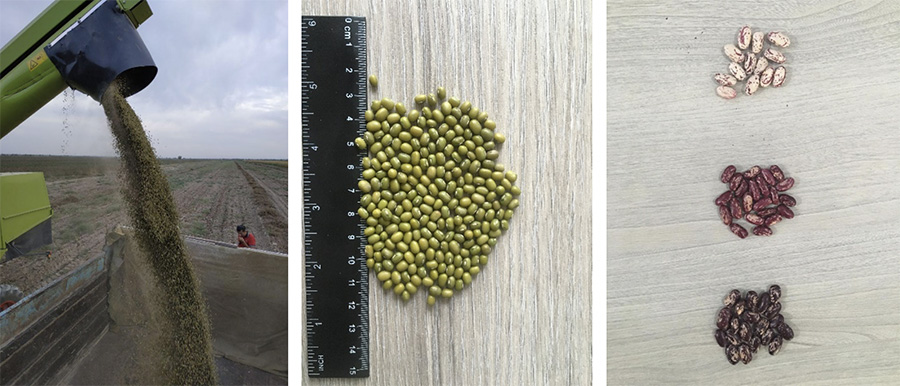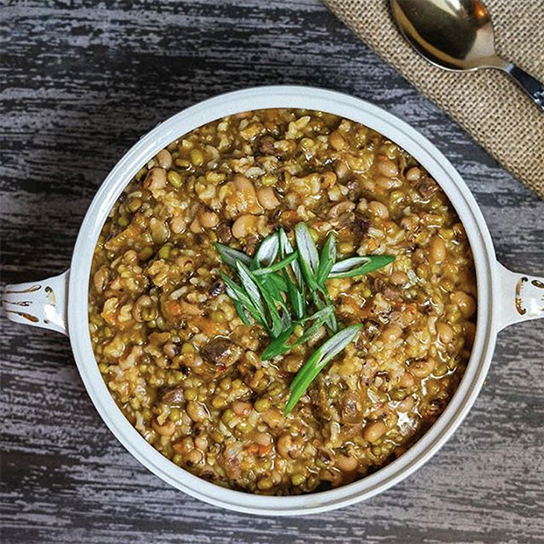October 17, 2019
As the country harvests the largest of its two pulse crops, the GPC gets the inside scoop from a main producer and exporter.



Uzbekistan has been at the crossroads of trade since the time of Alexander the Great and Genghis Khan, its storied cities—Samarkand, Bukhara and Khiva—immortalized in the chronicles of Marco Polo. It should come as no surprise, then, to learn that, despite being doubly landlocked, modern day Uzbekistan continues to be an important trading nation.
In the case of pulses, its major exports are mung beans, kidney beans and chickpeas. Although it lacks direct access to the sea, its geographic location is an advantage nonetheless. Uzbek pulse traders benefit from their proximity to major pulse markets, including India and China, both of which they can reach by land. For clients overseas, product is trucked or railed to the port cities of Mersin, Bandarabbas, Jebel Ali and Vladivostok, and loaded onto ships from there.
This month, Uzbekistan is harvesting the largest of its two pulse crops. Just as the first of the crop was coming off the fields, GPC was fortunate enough to interview Abbos Botirov, director of exports at the Global Export Company, a main producer and exporter of pulses in Uzbekistan. Asked for his production expectations, Abbos shared the figures in the chart below. He also took time out during this busy time of the year to speak with us about the pulse sector in his country.

Source: Global Export Company
Abbos: I’m originally from Uzbekistan. I got my start in the pulse business in 2011, when I interned for the pulse trading company New Way Industries while a student at Singapore University. I was responsible for sales and identified the market potential of Uzbek pulse exports.
Because of favorable climate conditions, we produce high quality pulses in Uzbekistan. Our summers are hot and dry, with 15 hours of sunlight per day, which means we get the same level of sunlight as California. This helps us produce green mung beans that are on par with Myanmar’s in terms of quality, but much more competitively priced. For instance, the smallest grain size is 2.7 mm and our mung beans can get as big as 5 mm. The color is also a nice light green because of good sunlight and limited moisture during the growing season.
So I saw the opportunity there and after I graduated from Singapore University, I went to work at the Ministry for Foreign Trade of the Republic of Uzbekistan, where I was responsible for promoting the country’s pulse exports. Due to my excellent experience in government, I was hired by the Global Export Company in 2017 as the director of exports to increase the company’s export potential.
Abbos: The company was established in Tashkent in May of 2017 and quickly became Uzbekistan’s largest pulse producer and exporter. It accomplished this thanks to the great teamwork of highly skilled staff, together with the biggest and most technologically advanced processing plants in the country. We also counted with large capital investments and earned important international certifications. Our facilities are certified ISO22000 and ISO9001. Over the next month, we will also receive FSSC22000 and GLOBALG.A.P. certification.
Another key factor is that the company owns 25,000 hectares of farmland that it uses to grow its own crops, thereby reducing the cost of raw materials. In this way we also maintain strict control of product quality from the field to the loading station. Along the way, product passes through our high-tech processing facilities with capacity to process 300 MT per day, and we package the product in various types of bags as per the request of our customers.
We work with green mung beans, red speckled kidney beans, purple speckled kidney beans, black-eye beans and chickpeas. The company has three facilities and a total processing capacity of 100,000 MT per year. We export 35,000 MT of pulses per year.
Abbos: In addition to the favorable climate, there are also important government benefits. For instance, the government finances and supports pulse growers because the cost of production per hectare is lower than for cotton, the main cash crop for Uzbek farmers. The government is also interested in incentivizing exports. In the case of pulses, exporters do not pay any taxes on product they send abroad. And lastly, the government subsidizes 50% of the railway freight cost for mung beans because of the strong demand. This is particularly relevant for trade with China. There are direct rail lines from Uzbekistan to many cities in China, and so we can offer buyers there greatly reduced transportation costs. In fact, last year exports to China increased by more than 50%.
Abbos: In Uzbekistan, we grow green mung beans, kidney beans and chickpeas. These crops are grown in all regions of the country except for northern regions like Karakalpakstan. The highest quality pulses are produced in the south and east, in regions like Syrdarya, Namangan, Jizzakh, Ferghana and Tashkent.
We harvest two pulse crops a year. The first crop is planted from April to May and harvested from June to July. It accounts for 10% of annual production. The second crop is the big one. It is planted in July and harvested now, in October. It accounts for 90% of annual production.
Abbos: Weather conditions were suitable for a very good crop. Last season, we had a lot of rain at harvest and more than 40% of the crop was destroyed, which resulted in very high prices. This season, because the weather has been so good, crop damage was only 1 to 2%, which positively influenced the pulse industry here in Uzbekistan.
On green mung beans, we are looking at a premium quality crop, with large calibers. We are also looking at high quality and large caliber light speckled kidney beans. On the purple speckled kidney beans and the black-eye beans, the quality is good and the caliber sizes are medium. On chickpeas, the quality is also good and the calibers are small. For all pulse crops, the moisture level is in the 8 to 12% range, no higher.

Caption: Photos courtesy of the Global Exchange Company.
Abbos: Pulses are not all that popular in Uzbek households. We consume green mung beans, chickpeas and black-eye beans. But only about 15% of production goes to the internal market. The rest is exported.
More precisely, about 14% of green mung bean production stays in the country. For chickpeas and black-eye beans, its 25% and 16% respectively. For others, its 10% for red speckled kidney beans, 6% for purple speckled kidney beans and just 2% of the light speckled kidney bean crop.
Abbos: Pulses are consumed as part of various dishes and also in salads. There is a traditional Uzbek dish called moshkichiri, a type of porridge made with mung beans, meat, onion and potatoes, but it is not consumed in great quantities.
Kidney beans are not used that much in Uzbek cuisine. Sometimes people add them to salads.

Caption: Moshkichiri, a traditional Uzbek porridge made with mung beans, meat, onion and potatoes. Photo courtesy of the Global Export Company.
Abbos: Right, besides China, there is Vietnam, India, Turkey, Iran, Afghanistan, Pakistan, Kazakhstan, the UAE and Georgia.
In my opinion, this year we will see green mung bean exports increase by more than 25% because of the large harvest thanks to favorable weather, and also because of strong demand from China and decreasing freight costs between our two countries. In addition to the government subsidy I mentioned, Chinese transport companies offer us very low freight rates to send containers back to China because imports from China to Uzbekistan are significantly higher than the other way around.
For red and purple speckled beans, exports will decrease by 10 to 15% because farmers opted to plant more mung beans and fewer of these types of kidney beans.
The same is true for chickpeas. The production cost of chickpeas was high last year and farmers opted for green mung beans and kidney beans instead.
For light speckled kidney beans, I’m forecasting an increase in exports because, in terms of economy of scale, it is the most profitable product. Also Iran, Turkey and India began buying from Uzbekistan because we offer lower prices than China.
Abbos: It significantly impacted our exports in the beginning. In the case of green mung beans, India had previously taken 75% of our export volume, but with the restrictions, that came to an abrupt stop. However, the government signed an agreement with China and starting in March 2018 Uzbek mung beans were cleared for import into that market, and we saw a sharp increase in exports and prices.
Today, the top markets for Uzbek green mung beans are China, Vietnam, Turkey, Europe and South Korea, among others.
Abbos: Domestic demand for pulses is unquestionably increasing as the population of Uzbekistan continues to grow and consumer interest in healthy foods is on the rise. Even so, export demand continues to outpace domestic demand. Because of this, more and more farmers are opting to plant pulses over other agricultural products.